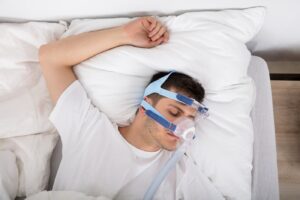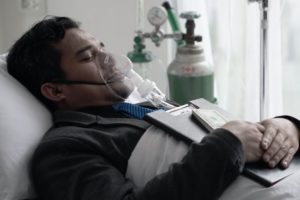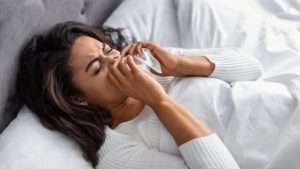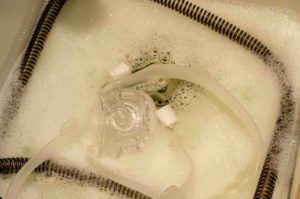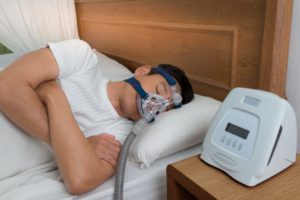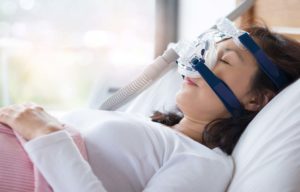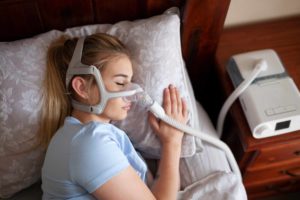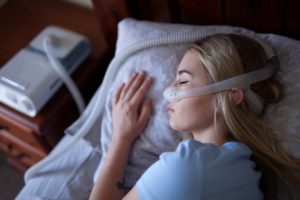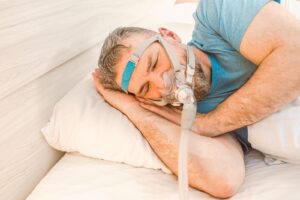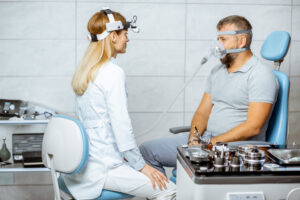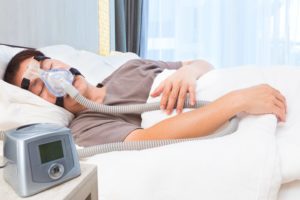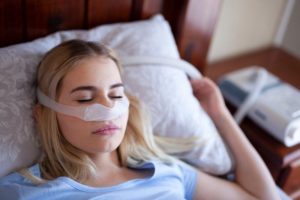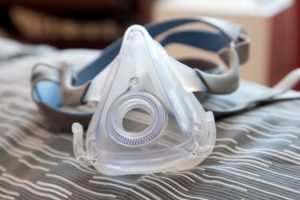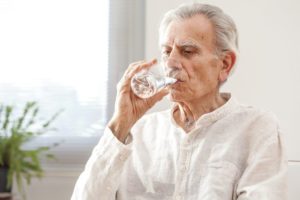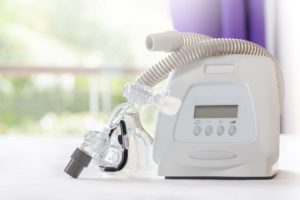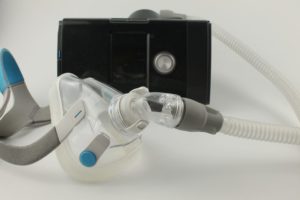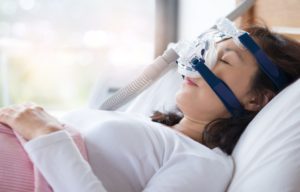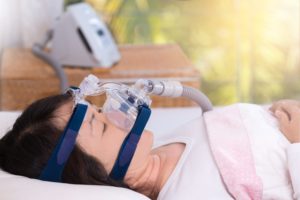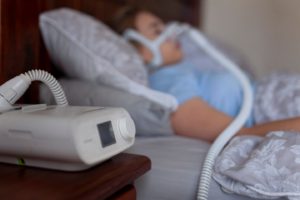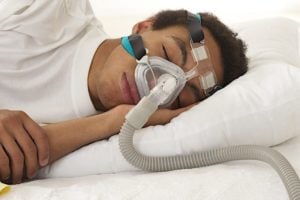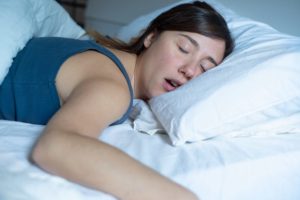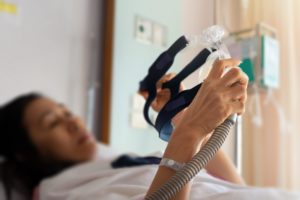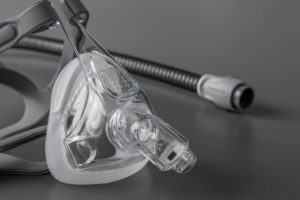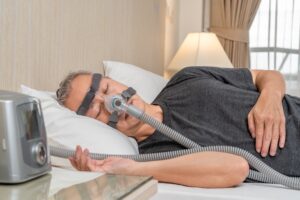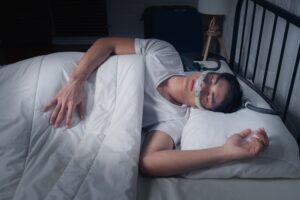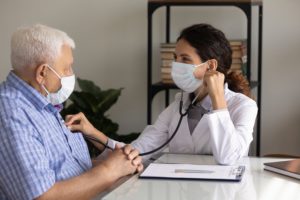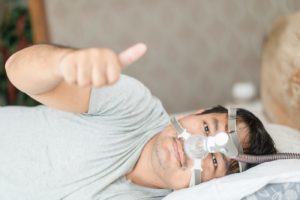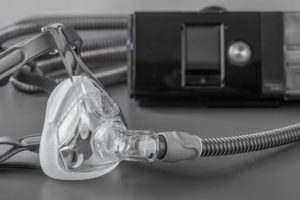When you buy through our links, we may earn a commission. Products or services may be offered by an affiliated entity. Learn more.
CPAP Benefits
- CPAP therapy treats sleep apnea by delivering constant airflow that keeps airways open during sleep, working to prevent breathing interruptions and maintain oxygen levels.
- Using CPAP therapy can offer both immediate and long-term health benefits, including better sleep quality, reduced daytime sleepiness, improved heart health, and reduced snoring.
- Maximizing CPAP benefits requires consistent nightly use, proper mask fit, regularly cleaning your equipment, and follow-up appointments with your healthcare provider.
- Alternative treatments for sleep apnea include oral appliances, positional therapy, weight loss, lifestyle changes, and surgery.
Obstructive sleep apnea (OSA) is a common sleep-related breathing disorder that affects an estimated 10 to 30% of people living in the United States. People living with sleep apnea typically experience interruptions in breathing during sleep that can lead to snoring, daytime sleepiness, and overall poor quality sleep. When left untreated, OSA may lead to more severe health conditions, including cardiovascular issues, stroke , and depression .
Continuous positive airway pressure (CPAP) therapy can be an effective treatment method for sleep apnea and its associated symptoms. We discuss the benefits of using CPAP and how to maximize them, along with alternative treatment options to help you choose the best plan for your needs.
How CPAP Therapy Works
During CPAP therapy, a machine delivers pressurized air through a mask into your airway to treat OSA symptoms. The mask may cover the nose, mouth, or both (depending on what your doctor thinks is best for your diagnosis), and air flows in through a tube connected to the CPAP machine. This steady stream of air helps keep airways open and prevents throat muscles and soft tissues from collapsing and blocking airflow.
Usually, you can expect your doctor to calibrate the machine’s pressure settings based on your sleep study results. The continuous flow of pressurized air prevents the breathing interruptions that characterize sleep apnea, stabilizes breathing patterns, and helps maintain oxygen levels throughout the night.
Consistent use of CPAP therapy can treat sleep apnea symptoms including snoring, gasping, morning headaches, and daytime fatigue.
Benefits of Using a CPAP Machine
Beyond treating the breathing interruptions of sleep apnea, CPAP therapy can offer a wide variety of health benefits in both the short and long term.
Better Sleep Quality
People who have sleep apnea may wake dozens of times or more throughout the night because of disrupted breathing. Often these sleep interruptions are too brief to notice, but they can reduce quality of sleep and can contribute to symptoms of insomnia. When used consistently, a CPAP machine can help regulate breathing, preventing nighttime wake-ups and improving overall quality of sleep.
Improved Heart Health
Research suggests that CPAP therapy may improve cardiovascular health in people with OSA, though more research is needed.
CPAP therapy may also help with:
- Blood pressure: Studies show that CPAP therapy can help lower blood pressure, even if the CPAP user did not have high blood pressure before beginning treatment. Keeping blood pressure in a healthy range can help reduce the risk of stroke and heart disease.
- Arrhythmia: Heart arrhythmias are events where the heart beats too slow, too fast, or irregularly. Early research suggests that CPAP use can reduce the occurrence of nighttime arrhythmias.
Lower Stroke Risk
Some research suggests that treating OSA may lower a person’s risk of having a stroke. This may be because CPAP therapy lowers high blood pressure, a risk factor for stroke.
Many people who have a stroke also have OSA. Limited research suggests that CPAP treatment may improve health outcomes in people with sleep apnea who have had a stroke.
More research is needed to understand the relationship between CPAP therapy and stroke.
Less Daytime Sleepiness
Because sleep apnea can disrupt sleep or reduce the total amount of time spent sleeping at night, the disorder can lead to daytime sleepiness. Daytime sleepiness refers to being unusually sleepy during portions of the day when people normally feel alert and awake. Some people with sleep apnea experience excessive daytime sleepiness where symptoms of daytime sleepiness persist for three months or more.
Most people undergoing CPAP therapy experience a decrease in daytime sleepiness. Some research suggests that as many as 75% of people who use CPAP therapy for OSA resolve their daytime sleepiness symptoms. The number of hours a person uses CPAP and the severity of daytime sleepiness may influence how well therapy works.
Lower Risk of Car Accidents
Insufficient sleep caused by obstructive sleep apnea is linked to a higher risk of vehicle accidents . Without enough quality sleep, people respond slower, have greater difficulty making decisions, and struggle to focus on simultaneous tasks, all of which affect driving. Treating OSA is key to preventing these accidents.
Drivers who use CPAP therapy are at a much lower risk for near-miss accidents and vehicle crashes. The effectiveness of CPAP treatment in preventing car accidents depends on a person consistently using CPAP.
Improved Mental Health
People with untreated OSA are at greater risk for mental health issues including depression, moodiness, and irritability. Some studies suggest that there is also an association between sleep apnea and anxiety .
Research has demonstrated that regular use of CPAP therapy to treat sleep apnea can lessen symptoms of depression . Some studies have also found that people who use their CPAP machine as prescribed may experience less depression . More research is needed to understand the effect of CPAP for OSA on improvements in mental health.
Less Snoring
Snoring is among the most common obstructive sleep apnea symptoms. People living with OSA who snore are sometimes unaware of the behavior. However, snoring can be disruptive to people who share a room or bed with a person with sleep apnea.
Snoring occurs when the airway narrows and the tissues in the airway vibrate. Because a CPAP mask prevents the airway from closing, many people with OSA who use CPAP experience less snoring. In some cases, snoring may be completely resolved.
Better Blood Sugar Control
Research suggests that CPAP therapy may improve blood sugar control in those who have both sleep apnea and type 2 diabetes. Some studies have found that consistent CPAP treatment for these patients can lead to reductions in blood glucose levels and improvements in long-term blood sugar control.
Improved Sexual Function
Men with sleep apnea may experience erectile dysfunction. However, studies have found that CPAP therapy can reduce, or partially reverse, sexual dysfunction in men with consistent long-term use. The benefits were most significant in severe cases.
Research on CPAP’s effects on sexual function in women is more limited, though some studies have suggested it may lead to improvement.
How to Maximize the Benefits of CPAP Therapy
Getting the most out of CPAP therapy requires proper equipment, consistent use, and regular maintenance. Here are tips to maximize the benefits of your treatment.
Ensure Proper Mask Fit
A well-fitting mask is essential for effective CPAP therapy. Masks that don’t fit may result in air leaks or general discomfort that can discourage use. Work with your health provider to find a mask that fits your face well and accommodates your sleeping position – it shouldn’t feel too tight or loose. You may also ask about getting a mask that is more lightweight or cushioned, or one that is only used around the nostrils.
Use CPAP Every Night
It’s important to use your CPAP machine every time you sleep, including naps and travel. While consistent use over time is crucial to take advantage of CPAP’s long-term benefits, studies have shown that even short breaks from the therapy have immediate negative effects on blood pressure and quality of sleep.
Keep Equipment Clean
Regular cleaning helps maintain equipment performance and extends its lifespan. While manufacturers recommend daily cleaning, research suggests there is little risk of infection if you miss a day or two. You generally don’t need a special device for cleaning – just follow manufacturer instructions to disassemble the parts and clean them with mild soap and water. You should also be sure to replace filters consistently (usually every one to three months) based on manufacturer instructions.
Give Yourself Time to Adjust
The first few nights of sleeping with a CPAP machine are often difficult. You may feel closed in, have a dry mouth, or feel slight discomfort in your chest muscles. You may simply not be used to the noise. This is all normal, and most people adjust within a few days. However, if your discomfort continues to the point where you are tempted to stop treatment, talk to your healthcare provider. There are many steps you can take to prevent discomfort such as adjusting the humidity settings, getting a more suitable mask, or finding a quieter machine.
Adjust Humidity Settings
Many CPAP machines include a heated humidifier to reduce dryness in your nose, mouth, and throat. Experiment with different humidity levels to find what works best for you. Higher humidity settings can help if you experience nasal congestion or dry mouth, while lower settings may be better if you notice water condensation in your tubing.
Follow Up With Your Healthcare Provider
Regular check-ins with your healthcare provider help ensure your CPAP therapy remains effective. These appointments allow you to voice any concerns or problems, and let the physician adjust pressure settings if needed. Many insurance plans require periodic follow-ups to continue coverage of CPAP equipment and supplies.
Need a CPAP Prescription? Start Here.

our partner at sleepdoctor.com
10% off Home Sleep Tests
Buy Now“Truly grateful for this home sleep test. Fair pricing and improved my sleep!”
Dawn G. – Verified Tester
Deciding if CPAP Is Right for You
CPAP is considered the most effective therapy for OSA, though the treatment may not be a good option for everyone. People considering CPAP as a treatment for their sleep apnea can choose to perform an at-home sleep study and should talk with their doctor about the risks and benefits of the therapy.
For some people, such as adults over the age of 80, CPAP therapy may be less effective. Other CPAP users may experience side effects such as aerophagia or excess swallowing of air, facial discomfort, and dryness in the nose or mouth. These side effects can make it difficult for some users to continue with therapy.
If you are using CPAP therapy to treat your OSA and you have questions about whether the treatment is right for you, consult your health care provider and make sure to find the best CPAP machine for your needs.
Alternatives to CPAP
There are several alternatives to CPAP therapy to treat OSA. Some of these approaches can be used in combination to help reduce symptoms.
- Oral appliance: An oral appliance keeps the mouth open and the jaw forward to prevent airway obstruction. Oral appliances are the most frequently used treatment for sleep apnea aside from CPAP. For people with mild sleep apnea, oral appliances can be very effective.
- Changing sleep position: Back sleeping worsens the symptoms of OSA for more than 50% of people with the disorder. Side sleeping, stomach sleeping, or back sleeping at a raised angle of 60 degrees can help improve symptoms. Consider finding a pillow for sleep apnea to help you stay in an optimal position all night.
- Weight loss: Being overweight or obese can increase your risk of sleep apnea. There is evidence that weight loss can decrease the number of episodes of stopped breathing during sleep by 26%.
- Lifestyle changes: Avoiding alcohol or sedatives before bedtime may help relieve symptoms of sleep apnea. Additionally, improved diet and increased exercise may reduce the severity of the condition.
- Surgery: Some people with OSA who do not respond to other treatments may benefit from surgery. Possible surgeries include the removal of the tonsils or excess throat tissue, repositioning of the jaw, and removal of nasal obstructions.
Frequently Asked Questions
How long does it take to see benefits from CPAP?
Within a few days of starting CPAP therapy, many patients notice positive changes such as better sleep quality, reduced snoring, and less daytime sleepiness. However, your experience may vary depending on a number of factors, including the severity of your sleep apnea. Long-term benefits such as lower blood pressure and improved heart health develop over time with consistent nightly use.
What happens if I skip CPAP for a night?
If you skip CPAP for a night, you may notice a temporary return of sleep apnea symptoms such as snoring, morning headache, or daytime fatigue. However, these symptoms should improve once you resume CPAP. Missing an occasional night is unlikely to cause long-term health problems, but consistent nightly use over time is important for managing sleep apnea and its associated health risks.
Can CPAP help with weight loss?
Though being overweight is a risk factor for sleep apnea, CPAP therapy alone does not typically lead to weight loss. Research shows that CPAP treatment may actually lead to modest weight gain, particularly in people who use CPAP less than five hours per night. However, the risk of weight gain is minimal for those who use CPAP consistently for at least five hours per night. If weight loss is a goal, lifestyle modifications including diet and exercise should be combined with CPAP therapy.
Medical Disclaimer: The content on this page should not be taken as medical advice or used as a recommendation for any specific treatment or medication. Always consult your doctor before taking a new medication or changing your current treatment.

Still have questions? Ask our community!
Join our Sleep Care Community — a trusted hub of product specialists, sleep health professionals, and people just like you. Whether you’re searching for the perfect mattress or need expert sleep advice, we’ve got you covered. Get personalized guidance from the experts who know sleep best.
References
21 Sources
-
Kline, L. R. (2022, April 1). Clinical presentation and diagnosis of obstructive sleep apnea in adults. In N. Collop (Ed.). UpToDate.
https://www.uptodate.com/contents/clinical-presentation-and-diagnosis-of-obstructive-sleep-apnea-in-adults -
Culebras, A. (2021, June 18). Sleep-related breathing disorders and stroke. In M. S. Badr (Ed.). UpToDate.
https://www.uptodate.com/contents/sleep-related-breathing-disorders-and-stroke -
Faria, A., Allen, A. H., Fox, N., Ayas, N., & Laher, I. (2021). The public health burden of obstructive sleep apnea. Sleep Science, 14(3), 257–265.
https://pubmed.ncbi.nlm.nih.gov/35186204/ -
Mehra, R. (2021, August 25). Obstructive sleep apnea and cardiovascular disease in adults. In N. Collop (Ed.). UpToDate.
https://www.uptodate.com/contents/obstructive-sleep-apnea-and-cardiovascular-disease-in-adults -
CPAP rapidly improves blood pressure and arterial tone in adults with sleep apnea. American Academy of Sleep Medicine – Association for Sleep Clinicians and Researchers. Published June 1, 2014. https://aasm.org/cpap-rapidly-improves-blood-pressure-and-arterial-tone-in-adults-with-sleep-apnea/
https://aasm.org/cpap-rapidly-improves-blood-pressure-and-arterial-tone-in-adults-with-sleep-apnea/ -
Varga PC, Rosianu HS, Vesa ŞC, Hancu BGD, Beyer R, Pop CM. The impact of continuous positive airway pressure on cardiac arrhythmias in patients with sleep apnea. J Res Med Sci. 2020;25:42. Published 2020 Apr 13. doi:10.4103/jrms.JRMS_677_18
https://pmc.ncbi.nlm.nih.gov/articles/PMC7306230/ -
Khot SP, Davis AP, Crane DA, et al. Effect of Continuous Positive Airway Pressure on Stroke Rehabilitation: A Pilot Randomized Sham-Controlled Trial. J Clin Sleep Med. 2016;12(7):1019-1026. Published 2016 Jul 15. doi:10.5664/jcsm.5940
https://pmc.ncbi.nlm.nih.gov/articles/PMC4918984/ -
Bonsignore, M. R., Pepin, J. L., Cibella, F., Barbera, C. D., Marrone, O., Verbraecken, J., Saaresranta, T., Basoglu, O. K., Trakada, G., Bouloukaki, I., McNicholas, W. T., Bailly, S., Pataka, A., Kvamme, J. A., Hein, H., Mihaicuta, S., Grote, L., & Fanfulla, F. (2021). Excessive daytime sleepiness in obstructive sleep apnea patients treated with continuous positive airway pressure: Data from the European sleep apnea database. Frontiers in Neurology, 12.
https://pubmed.ncbi.nlm.nih.gov/34434158/ -
Cirelli, C. (2022, March 13). Insufficient sleep: Definition, epidemiology, and adverse outcomes. In R. Benca (Ed.). UpToDate.
https://www.uptodate.com/contents/insufficient-sleep-definition-epidemiology-and-adverse-outcomes -
Kaufmann, C. N., Susukida, R., & Depp, C. A. (2017). Sleep apnea, psychopathology, and mental health care. Sleep health, 3(4), 244–249.
https://pubmed.ncbi.nlm.nih.gov/28709510/ -
Zheng, D., Xu, Y., You, S., Hackett, M. L., Woodman, R. J., Li, Q., Woodward, M., Loffler, K. A., Rodgers, A., Drager, L. F., Lorenzi-Filho, G., Wang, X., Quan, W. W., Tripathi, M., Mediano, O., Ou, Q., Chen, R., Liu, Z., Zhang, X., … Anderson, C. S. (2019). Effects of continuous positive airway pressure on depression and anxiety symptoms in patients with obstructive sleep apnoea: Results from the sleep apnoea cardiovascular Endpoint randomised trial and meta-analysis. EClinicalMedicine, 11, 89–96.
https://pubmed.ncbi.nlm.nih.gov/31312807/ -
Walker, A., Naughton, M. T., Shaw, L., Jeklin, A. T., Martin, C., & Dabscheck, E. (2021). Depression scores improve with continuous positive airway pressure in specialized sleep clinics: Real-world data. Journal of Clinical Sleep Medicine, 17(6), 1201–1209.
https://pubmed.ncbi.nlm.nih.gov/33590822/ -
Zhao X, Zhang W, Xin S, Yu X, Zhang X. Effect of CPAP on blood glucose fluctuation in patients with type 2 diabetes mellitus and obstructive sleep apnea. Sleep Breath. 2022;26(4):1875-1883. doi:10.1007/s11325-021-02556-0
-
Schulz R, Bischof F, Galetke W, et al. CPAP therapy improves erectile function in patients with severe obstructive sleep apnea. Sleep Med. 2019;53:189-194. doi:10.1016/j.sleep.2018.03.018
https://pubmed.ncbi.nlm.nih.gov/29773460/ -
Petersen, M., Kristensen, E., Berg, S., & Midgren, B. (2013). Long-term effects of continuous positive airway pressure treatment on sexuality in female patients with obstructive sleep apnea. Sexual Medicine, 1(2), 62–68.
https://pubmed.ncbi.nlm.nih.gov/25356289/ -
A.D.A.M. Medical Encyclopedia. (2023, April 20). Positive airway pressure treatment. MedlinePlus.
https://medlineplus.gov/ency/article/001916.htm -
Schwarz EI, Stradling JR, Kohler M. Physiological consequences of CPAP therapy withdrawal in patients with obstructive sleep apnoea-an opportunity for an efficient experimental model. J Thorac Dis. 2018;10(Suppl 1):S24-S32. doi:10.21037/jtd.2017.12.142
https://pmc.ncbi.nlm.nih.gov/articles/PMC5803046 -
Omobomi, O., & Quan, S. F. (2017). Positional therapy in the management of positional obstructive sleep apnea—a review of the current literature. Sleep and Breathing, 22(2), 297–304.
https://pubmed.ncbi.nlm.nih.gov/28852945/ -
Alruwaily A, Alruwaili H, Garvey J, le Roux CW. Can Weight Loss Improve the Cardiovascular Outcomes of Patients with Obesity and Obstructive Sleep Apnea? Hearts. 2022; 3(2):54-65. https://doi.org/10.3390/hearts3020008
https://www.mdpi.com/2673-3846/3/2/8 -
Chen, B., Drager, L. F., Peker, Y., Vgontzas, A. N., Phillips, C. L., Hoyos, C. M., Salles, G. F., Guo, M., & Li, Y. (2021). Effect of continuous positive airway pressure on weight and local adiposity in adults with obstructive sleep apnea: A meta-analysis. Annals of the American Thoracic Society, 18(10), 1717–1727.
https://pubmed.ncbi.nlm.nih.gov/33740390/ -
Drager, L. F., Brunoni, A. R., Jenner, R., Lorenzi-Filho, G., Benseñor, I. M., & Lotufo, P. A. (2015). Effects of CPAP on body weight in patients with obstructive sleep apnoea: A meta-analysis of randomised trials. Thorax, 70(3), 258–264.
https://pubmed.ncbi.nlm.nih.gov/25432944/




